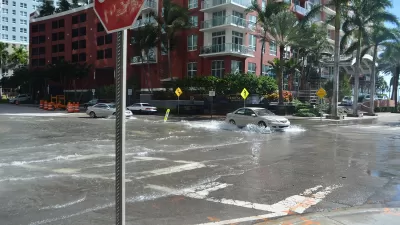After four years of political wrangling, hundreds of public and internal meetings, several revisions, and one determined planning department, consultant team, and Mayor, the City of Miami made urban planning history tonight by adopting the largest known application of a form-based code. In doing so, Miami has catapulted itself to the forefront of those large American cities serious about implementing smart growth.
After four years of political wrangling, hundreds of public and internal meetings, several revisions, and one determined planning department, consultant team, and Mayor, the City of Miami made urban planning history tonight by adopting the largest known application of a form-based code. In doing so, Miami has catapulted itself to the forefront of those large American cities serious about implementing smart growth.
To be sure, certain elements of the code remained controversial, such as a 35 foot height limit proposed--and adopted-- for a large stretch of the city's most important corridor, yet City Commissioners admirably managed to vote 4-1 in favor of officially replacing the city's outmoded use-base zoning code with a form-based code. Interestingly, Sandy Sorlien, a form-based code expert, also reports that the small town of Jamestown, Rhode Island adopted a form-based code this evening.
While dozens of lessons may now be learned from the Miami 21 process, a few other large cities are already ready to ditch their own sprawl inducing codes for a more sustainable pattern of growth. Denver, for example, will likely adopt its own comprehensive form-based code in a matter of months.
Miami 21 is not perfect, but its implementation will allow all practicing planners and advocates of form-based codes alike to study and learn from the successes and failures of Miami's process and eventual results. For that, I hope you can join me in congratulating the City of Miami (and Jamestown) for taking a bold step forward in pursuing a more sustainable 21st century American city.

Maui's Vacation Rental Debate Turns Ugly
Verbal attacks, misinformation campaigns and fistfights plague a high-stakes debate to convert thousands of vacation rentals into long-term housing.

Planetizen Federal Action Tracker
A weekly monitor of how Trump’s orders and actions are impacting planners and planning in America.

In Urban Planning, AI Prompting Could be the New Design Thinking
Creativity has long been key to great urban design. What if we see AI as our new creative partner?

King County Supportive Housing Program Offers Hope for Unhoused Residents
The county is taking a ‘Housing First’ approach that prioritizes getting people into housing, then offering wraparound supportive services.

Researchers Use AI to Get Clearer Picture of US Housing
Analysts are using artificial intelligence to supercharge their research by allowing them to comb through data faster. Though these AI tools can be error prone, they save time and housing researchers are optimistic about the future.

Making Shared Micromobility More Inclusive
Cities and shared mobility system operators can do more to include people with disabilities in planning and operations, per a new report.
Urban Design for Planners 1: Software Tools
This six-course series explores essential urban design concepts using open source software and equips planners with the tools they need to participate fully in the urban design process.
Planning for Universal Design
Learn the tools for implementing Universal Design in planning regulations.
planning NEXT
Appalachian Highlands Housing Partners
Mpact (founded as Rail~Volution)
City of Camden Redevelopment Agency
City of Astoria
City of Portland
City of Laramie




























